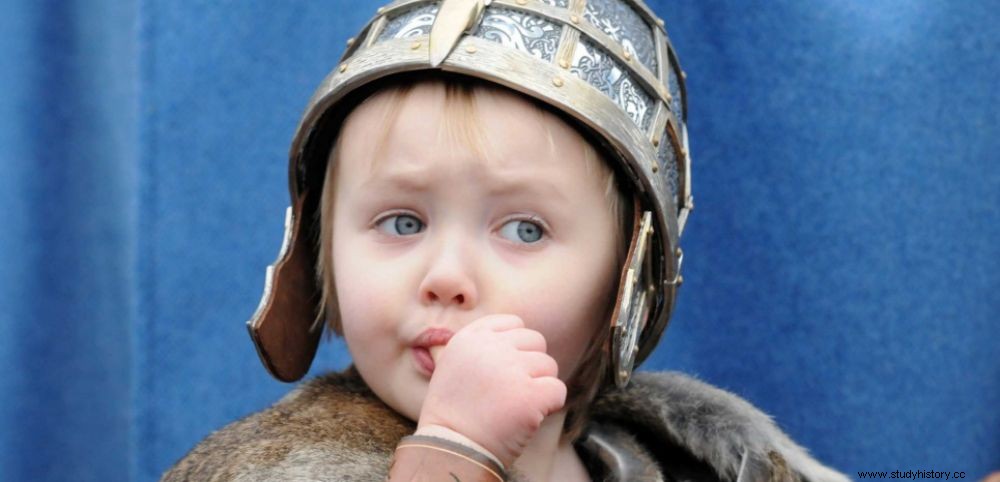 A genetic study has determined that some modern-day Normans are likely descendants of the Vikings.
A genetic study has determined that some modern-day Normans are likely descendants of the Vikings. ANCERS. "The men of the north" is the literal meaning of the word "Normans". And if today the term is used to designate the inhabitants of Normandy, it was formerly used to speak of the Vikings, this Scandinavian people who landed on the French coasts of the Channel at the end of the 1st millennium of our era. So, can the Normans of today still be proud to be the direct descendants of these fearsome Nordic warriors of the Middle Ages? "Maybe yes, maybe no", in the light of a genetic study whose first results were unveiled on Thursday April 21, 2016. The result of collaborative work between British and French researchers* , the "Viking DNA Project" aims to determine if, at the heart of the cells of the Normans of today, a "signature" could have been left by the Vikings. However, this signature is not always very readable.
A Viking DNA signature
Normandy is of interest to scholars because it is the only enduring political foundation established by the Vikings on the continent. The scientists also focused their study on the population of the Cotentin peninsula, because the density of places and people whose names are of Scandinavian origin is particularly high there. "We were interested in men with surnames with Scandinavian-sounding elements that might reflect this heritage:names such as Anquetil, Dutot, Equilbec, Gonfray, Ingouf, Lanfry, Osouf, Osmont, Quetel, Tougis , Tostain, Raoult and their many variations , explains Richard Jones, of the University of Leicester (United Kingdom). We also selected only people whose four grandparents were born and lived within a 50 km radius of their current home. This stable residence is often indicative of a longer family history in a region In the end, the researchers selected 89 men according to these criteria. They had to complete a genealogical questionnaire and submit to a saliva test. The scientists then looked for a "Viking signature" on the Y chromosome (only present in male individuals and transmitted from father to son) extracted from cells contained in saliva. Concretely, they were interested in the genetic variations present on this chromosome. "These variations can be grouped according to several criteria. This allows an individual to be classified into a particular ‘haplogroup’ based on the type of variations detected in their DNA ", explains the British historian.
Results ? Of the 89 men who participated in the study, the vast majority (52) represented haplogroup R1b, the most common type of Y-chromosome variation in northern and western Europe. Its origin, still unclear, is to be found in steppe shepherds north of the Black Sea who immigrated to the West 4,000 years ago. It cannot therefore be a typical Viking signature. But without totally excluding it either:according to experts, this genetic variation could mean an indirect link with Vikings. On the other hand, haplogroup l1, found in 11 of the Normans in the study, more clearly suggests a possible Viking ancestry (more direct this time). These variations are indeed very present among the Scandinavians (more than 45% of the population belongs to this genetic group in certain regions). But a Germanic origin is also possible. In fact, "when we look at the underlying 'fingerprints' of haplogroup l1, some Norman Y chromosomes show Germanic affinity, while others reveal Scandinavian affinity ", specifies Richard Jones. Nevertheless, "it is very tempting to consider l1 as a mark left by the Vikings in Normandy, because it is present there in approximately the same proportions as those observed in other populations with a known Viking history ", adds the researcher. Finally, 2 participants presented a haplogroup often considered as typically Nordic:R1a. The other haplogroups found among the Normans are a priori unrelated to the Vikings. They would be witnesses of other origins, in particular around the Mediterranean (including Sicily and southern Italy, lands that belonged to the Norman Empire) and extending farther east to the Middle East and Eastern Europe (possibly going back at the time of the Crusades).
These results are however not definitive, but they already reflect a great genetic diversity within the Cotentin population. The researchers intend to refine their analysis of haplogroups in order to more clearly identify the geographical origins of each. They also want to study another type of genetic material:mitochondrial DNA (bequeathed this time by the mother to her children), which is even more complex to decipher. Finally, future methods of collecting ancient DNA may make it possible to harvest DNA from Viking skulls:it will then suffice to compare this authentic DNA to that of the Normans to find out if they are related, rather than trying to to trace the genetic trees by following the traces of a possible Viking signature. "Knowledge of the genetic history of Normandy is still in its infancy! “, enthuses Richard Jones.
* important collaborative work between the University of Leicester (United Kingdom) and the Center for Ancient and Medieval Archaeological and Historical Research UMR 6273 (CNRS / UCBN), University of Caen Basse-Normandie (France).
